Feeding baby red tail catfish
Feeding, Setup, Tank Mates & More
Red tail catfish are a favorite of aquarists in love with monster fish. They start out small and cute but grow to be absolutely massive. And in the process of getting bigger, they often end up eating several of their tank mates. While they are not sensitive fish, all of these elements make their care very complicated.
Can you deal with a 4-foot long predator that needs hundreds to thousands of gallons of space? Let’s take a closer look at the large and in-charge redtail catfish.
In This Article
- Getting to Know the Red Tail Catfish
- Redtail Catfish Care
- Minimum Tank Size
- Water Parameters for Red Tail Catfish
- Aquascaping for Redtail Catfish
- Redtail Catfish Tank Mates
- Feeding Redtail Catfish
- Breeding Redtail Catfish
- In Conclusion
- More Frequently Asked Questions about Red Tail Catfish
Getting to Know the Red Tail Catfish
Red tail catfish are some of the largest fish that are commonly found in the aquarium trade. Native to South America, they are found mostly in Venezuelan river basins. Here they go by the local name of cajaro. And in Brazil they are known as pirarara.
In their natural habitat, they are rarely hunted for food by the locals despite being edible because their dark flesh is seen as a sign of not being of good quality. However, redtail catfish have been introduced to tropical places around the world. In Southeast Asia, they are a favorite game fish and are eaten with delight.
South American redtail catfish are members of the family Pimelodidae, which is a group of small to large catfish that are predominantly fish-eating predators. Others in the group include the much smaller Pictus Catfish and the equally long but much more slender Tiger Shovelnose Catfish.
Other Pimelodid catfish species show up in the hobby now and again. But these three fish species are by far the most common compared to the others.
You may also see the Asian Redtail Catfish (Hemibagrus wyckioides) for sale sometimes.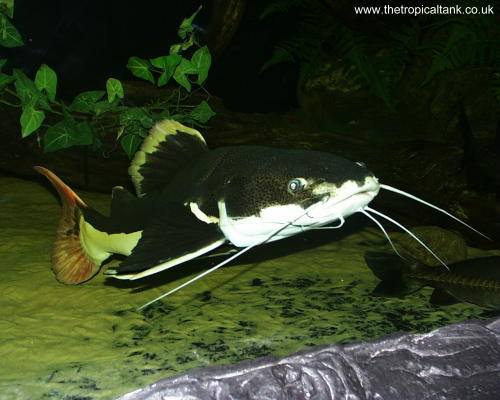 This is a much rarer, unrelated freshwater fish species that look quite different as well.
This is a much rarer, unrelated freshwater fish species that look quite different as well.
Asian Redtail Catfish also grows huge, surpassing 4 feet in length. However, they are slimmer than “true” redtail cats and they have a pale grey body that’s nothing like the bright black and white of the South American redtail catfish.
All in all, these fish species aren’t especially difficult to care for. Redtail catfish are exceptionally hardy and eager eaters. The main issue is that they require aquariums of 500 gallons or more as they mature, something well out of reach of the average aquarist. That said, if you’re ready to take on such a challenge, you’ll have an impressive pet that will live for up to 15 years.
- Scientific Name: Phractocephalus hemioliopterus
- Origin: South America in major river basins
- Length: 4 to 6 feet
- Aquarium Size: 500+ gallons
- Temperament: Semi-aggressive; Predatory
- Ease of Care: Moderate
Redtail Catfish Care
Redtail catfish care is both easy and difficult. Easy because they are fast growers and eager eaters. They are tolerant of a wide range of aquarium water conditions and don’t need much in terms of special care. But they can also be very difficult because they grow absolutely massive and will eat most of the other fish in your tank if you aren’t careful.
Easy because they are fast growers and eager eaters. They are tolerant of a wide range of aquarium water conditions and don’t need much in terms of special care. But they can also be very difficult because they grow absolutely massive and will eat most of the other fish in your tank if you aren’t careful.
Minimum Tank Size
A juvenile redtail catfish can be less than two inches long and looks adorable, with its black, white, and red patterns. But there’s no getting around the main difficulty to keeping red tail catfish: they grow fast and massive. 3 feet is on the smaller end for them, with 4 feet being a solid average. And in the unlimited confines of their home Orinoco and Amazonian River systems, they can reach up to six feet long.
Worse, that growth is incredibly quick. Redtail catfish size as a baby is just a few inches long. However, it will double its length in 2-3 months. In a year it will be fairly massive and by the next, you’ll need a yardstick to measure its length
That means the minimum tank size for an adult redtail catfish is at the very least 500 gallons in size. Probably larger, given the need for your fish to be able to turn around comfortably.
Probably larger, given the need for your fish to be able to turn around comfortably.
Many red tail catfish keepers place theirs in ponds – though you’d need to either be living in a tropical region or have a heated indoor pond to do so successfully.
A pond is an excellent way to provide perfect redtail catfish care because the walls can curve so they aren’t constantly running into them. Ponds hold much more water than all but the largest aquarium setup. And they offer much more space for you to choose equally large fish as tank mates for a redtail catfish.
Water Parameters for Red Tail Catfish
When it comes to water parameters red tail cats prefer conditions close to their native South American waters. That means soft conditions with moderate to low dissolved hardness (GH & KH), and moderate acidity (pH 5.5-7.0). That said, they are not picky and will continue to thrive even in the hard, alkaline water found in most tap water systems.
This adaptable nature can make them a problem in other parts of the world.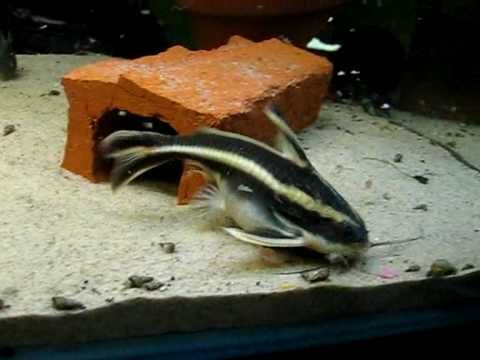 So long as the conditions are right redtail catfish will survive and thrive. This can be a very big problem for local species that are not used to a new super-predator on the block.
So long as the conditions are right redtail catfish will survive and thrive. This can be a very big problem for local species that are not used to a new super-predator on the block.
Water temperature, on the other hand, needs to remain elevated. 74-82℉ is an ideal range for them; avoid cooling them below this point. Like all fish, red tail catfish are endothermic, meaning their bodily systems are regulated by the outside water temperature. Cold water can slow down their digestion so much that food begins to rot within, causing bloating disorders that can easily be fatal.
The main thing to watch out for is ammonia levels. Redtail catfish are massive predators with an equally massive appetite. You will be shocked by how much these fish can put away – and how much comes out the other end. This means that they continually produce large amounts of nitrogenous waste which means you’ll need a substantial filtration system to keep it all under control.
Canister filters are the only real option; even the largest power filter won’t be able to process enough water to keep ammonia, nitrite, and nitrate levels at a healthy level. A canister filter can hold a few gallons of filter media, enabling it to scrub the water free of any pollutants.
A canister filter can hold a few gallons of filter media, enabling it to scrub the water free of any pollutants.
Power filters only work for baby redtail catfish, which can also be kept in smaller tank sizes. But you are only putting off the inevitable and it is better to invest in a large tank size and a proper canister filter right from the beginning.
Aquascaping for Redtail Catfish
When designing a tank for a redtail catfish space will always be the most important quality. When fully grown these freshwater fish will be able to knock over just about any decorations except for a large rock or piece of driftwood.
You can try keeping them with live plants but they are too likely to simply be uprooted accidentally over time. Plants don’t like being disturbed so often and will eventually die from being abused so often. So it’s better to stick with plastic or silk plants, which have the added advantage of not needing specialized full spectrum plant lighting.
If you are determined to keep live plants in a redtail catfish aquarium then you should stick mostly to epiphytes.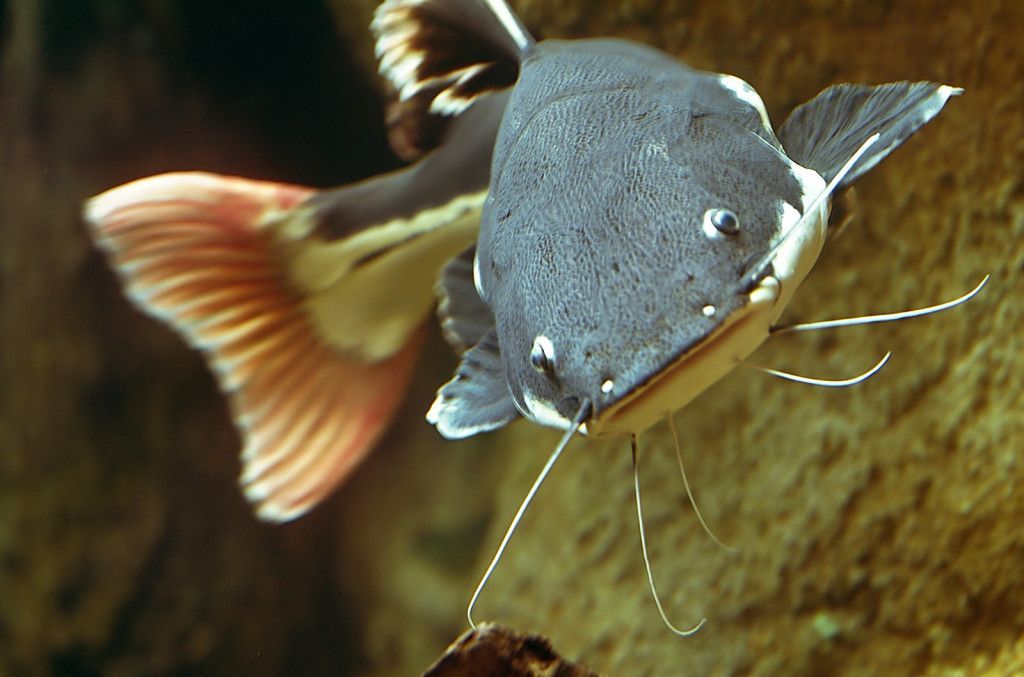 These are plants that grow on hard surfaces like rocks and driftwood. And once they are established they are almost impossible to rip free.
These are plants that grow on hard surfaces like rocks and driftwood. And once they are established they are almost impossible to rip free.
Popular epiphytes include Java Fern and Anubias. These plants also don’t need much in terms of lighting and are great low-light plants. Aquatic mosses like Java Moss will also do well in a redtail catfish aquarium.
Sand is the best substrate for redtail catfish of all sizes. While they don’t do much digging, gravel can sometimes get swallowed alongside a live fish meal that gets pinned to the bottom. Once eaten these gravel grains can potentially block the intestinal tract, which is almost always fatal. Sand grains are small enough that, if eaten, they will be passed safely.
Another option that many redtail catfish keepers opt for is to do away entirely with a substrate. Bare bottom aquariums have a major advantage: they are extremely quick to clean! A few quick passes with the siphon hose are all that’s needed to remove the obvious feces left behind. The main drawback is that it doesn’t look nearly as nice as a tank with a substrate, though.
The main drawback is that it doesn’t look nearly as nice as a tank with a substrate, though.
There is another reason why bare-bottomed tanks and ponds are so common besides ease of cleaning. By keeping things simple you won’t need to redo your aquascape every few weeks when the redtail catfish knocks things over. So be sure to take some extra time thinking about the substrate you have in mind!
Redtail Catfish Tank Mates
Choosing tank mates for redtail catfish needs to be done very, very carefully. Because these fish have a wide mouth, broad head, a giant appetite, and are active at night when most of their tank mates will be sleeping. Even fast-moving tank mates may end up disappearing, swallowed in their sleep by a hungry redtail catfish.
When small they can be kept with wide-bodied freshwater fish of equal size. Tiger Barbs, Silver Dollars, Gouramis, and Angelfish are suitable tank mates until the red tail catfish outgrows them.
But their rate of growth makes any peace very short-lived; you’ll need to be proactive about moving them to larger quarters and/or removing their edible tank mates every few months.
If you don’t want tank mates that will need to be moved lest they be eaten then choose fish that grow equally fast and that do well in a larger tank setup. Potential options include larger cichlids like Oscars and Peacock Bass. Arowanas and Stingrays are other popular tank mates that are unlikely to be eaten.
While they are voracious, red tail catfish aren’t really aggressive. They get along just fine with most large fish and even other bottom dwellers. They will ignore most of their tank mates unless it’s time to eat.
Some aquarists do report that their redtail catfish have more “personality” than most, however. That’s not uncommon for large fish, which are more intelligent and tend to recognize their owners and have strong personality quirks.
Many pimelodid catfish are outright vicious, including the well-named Black Devil Catfish (Hemibagrus wyckii). But red tails do fine with anything they can’t outright eat.
Good Tank Mates for Redtail Catfish:
- Oscars, Peacock Bass, Umbees, and other Large Cichlids
- Arowanas, Pacu, adult Plecostomus, Stingrays, and other Large Fish
Poor Tank Mates for Redtail Catfish
- Most freshwater Community Fish
Feeding Redtail Catfish
As you might expect, feeding a redtail catfish is as easy as it gets. These catfish will eat just about anything that hits the water so long as it has some meat in it! Most aquarists use a prepared pellet food formula, which is a great base for their diet.
These catfish will eat just about anything that hits the water so long as it has some meat in it! Most aquarists use a prepared pellet food formula, which is a great base for their diet.
But take the time to carefully read the ingredients label because many, if not most, brands use a lot of grain and starch-based fillers, like potato and cornmeal. Redtail catfish are predators and can’t digest all of that ground-up plant filler. You want to see fish meal, shrimp meal, and other animal protein sources as the first few ingredients.
You absolutely should offer your baby red tail catfish animal flesh as well. When small you can start out with thawed frozen brine shrimp, bloodworms, and tubifex worm masses. But as they grow insanely fast, these won’t be enough in just a few months’ time.
Many aquarists then start offering feeder goldfish, rosy reds, and guppies from their local store. While live fish are a natural food source for them, I don’t recommend taking this approach.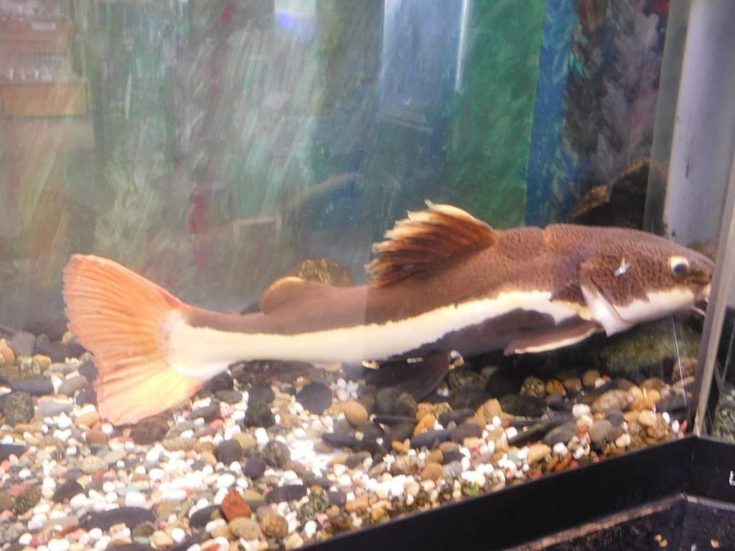 The problem with smaller fish is that they are kept in absolutely filthy conditions where parasites, bacteria, and fungal infections are the norm.
The problem with smaller fish is that they are kept in absolutely filthy conditions where parasites, bacteria, and fungal infections are the norm.
And when your red tail catfish eats one of these feeders they are potentially going to catch those same diseases. Unless you raise your own then don’t offer diseased food to your fish…
The best redtail catfish food is fresh meaty items like shrimp, scallops, and white fish. Stay away from chicken, pork, or beef, which are much too fatty. Stick to lean seafood only.
Breeding Redtail Catfish
Unfortunately, there are few to no examples of red tail catfish breeding in a home aquarium. These fish get too large to keep multiple side by side in anything but the very largest tanks. And their sexual characteristics are entirely unknown.
It’s likely that the red tail catfish can tell male from female fish using subtle behavioral cues and hormonal releases they pick up with their sensitive whiskers. But to us they appear identical; they aren’t sexually dimorphic fish.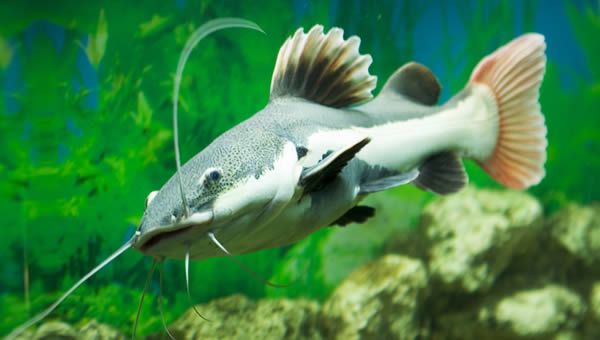
The breeding habits in the wild are also unknown. Many large Amazonian catfish in South America nest in mud holes along the river bank. The male will dig a nest using his tail for the female to deposit thousands of eggs within. The pair will then guard the eggs and often the fry once they’ve hatched for a few days or weeks until they grow large enough to fend for themselves.
For these reasons nearly all red tail catfish are wild-caught. Though if anyone were to breed them in captivity, it will likely be done using the methods being pioneered currently in Southeast Asia.
They keep several in a large outdoor pond in year-round tropical conditions. Sometimes hormonal injections are also used to stimulate egg and sperm production in adult fish. Since the demand for baby red tail catfish isn’t all that large there are no known captive breeding programs at present.
In Conclusion
Finally, we come to the last question: are redtail catfish right for me? Lovers of monster fish like Umbees, Pacus, and Oscars likely already know the answer – and have the space and resources required to successfully care for these mega fish.
But for the average aquarist, you should think long and hard before buying that cute baby redtail catfish from your local pet store. You may think you’ll eventually upgrade to a larger tank. But that upgrade will come a lot sooner than you think. Remember, a young red tail catfish can put on 1-2 inches of length per month.
Unless you’re absolutely certain you’re ready for the 15-year commitment that keeping redtail catfish requires, you shouldn’t give in to the impulse. Sometimes people think that they can simply take the red tail catfish to a pet store or public aquarium once it outgrows their tank.
But sadly, they are often mistaken. Pet stores and public aquariums get calls from people looking to rehome large fish on a weekly basis. They may not even have the space or resources to take on a large animal like a redtail catfish.
And letting it loose in the wild is by far the worst thing you could do. Invasive species like red tail catfish can do massive amounts of harm. They can drive local species to extinction when they eat smaller fish and introduce captive diseases to the game fish population.
They can drive local species to extinction when they eat smaller fish and introduce captive diseases to the game fish population.
These freshwater aquarium fish are unlikely to survive in all but the warmest of countries. But condemning your poor adult redtail catfish to freeze during the winter is both unkind and very irresponsible.
So think carefully; and if everything sounds good, then get ready for a fun time with a catfish that’s more like an aquatic dog than any other fish.
More Frequently Asked Questions about Red Tail Catfish
Are you still thinking hard about redtail catfish care and whether you are up to the challenge? Then you’ve come to the right place. Here are a few more frequently asked questions on how to care for an adult redtail catfish.
How Big Does a Red Tail Catfish Get?
Redtail catfish are some of the largest fish available for a home aquarium. A small fish may be only a few inches long. But these fish grow large and they do so very fast. As an adult, a redtail catfish will be anywhere from four to six feet long.
But these fish grow large and they do so very fast. As an adult, a redtail catfish will be anywhere from four to six feet long.
Are Red Tail Catfish Good to Eat?
Redtail catfish are indeed edible and as delicious as any other fish. However, in their natural habitats, they are rarely eaten because locals find their dark flesh to be offputting. There have been experiments to hybridize them with tiger shovelnose catfish in order to create a new food fish. These hybrids sometimes show up in the aquarium trade labeled as Tiger Redtail Catfish.
What Fish Can Live With a Red Tail Catfish?
Redtail catfish are predators but they aren’t very aggressive. Any fish small enough to disappear into their mouth will eventually do so. But any other fish that is large enough will be safe alongside them. Large cichlids, catfish, pacu, arowanas, and other large aquarium fish are therefore the best tank mates for a redtail catfish.
Are Red Tail Catfish Venomous?
Most catfish have spines with venom glands along the base and the redtail catfish is no exception. There have been no studies on the exact qualities of the venom and how dangerous it might be to humans. Most pimelodid catfish stings feel at worst like a bee sting. However, the puncture is very prone to get infected and should be cleaned and treated properly.
Ghost Shrimp (Compete Care, Diet, Setup, & Breeding Guide)
X-Ray Fish (Pristella Tetra) Species Profile, Care, and Breeding
About Jason Roberts
Jason is an aquarium fanatic that has been a fish hobbyist for almost three decades.
RedTail Catfish: Care | Size | Feeding | Cost
How to describe the RedTail Catfish? A monster of the deep? A gargantuan bottom feeder? A wide-mouthed beast? All things I have heard when referring to this magnificent creature. I, however, prefer to describe it as big and beautiful with enormous fish keeping appeal!
Here’s our Redtail catfish care guide to help you understand the specific and special needs of this huge catfish.
The last of their genus, the RedTail Catfish is believed to date back over 13.5 million years. They are a widely sought after game fish with the IGFA, (International Game Fish Association) recording the biggest ever caught weighing in at 123 lbs or 56 kilos. This titan of a catfish was caught by Giberto Fernandes in the Amazon river in 2010.
Also popular in the aquarist trade, mainly with ‘monster’ fish keepers, the RedTail Catfish is not a species to impulse purchase. Careful research and consideration of these fishes needs are vital and with that in mind, we’ve prepared for you a complete guide. It contains everything you need to know about the Red Tail Catfish (Phractocephalus hemioliopterus.)
Table of Contents
Redtail Catfish: Species Profile
| Scientific name | Phractocephalus hemioliopterus |
|---|---|
| Common Names | South American red tail, banana catfish, flat-nose catfish, antenna catfish, RTC |
| Family | Pimelodidae |
| Origin | South America |
| Lifespan | 20 years |
| Sociability | Peaceful but predatory |
| Growth | 3-4 feet in captivity.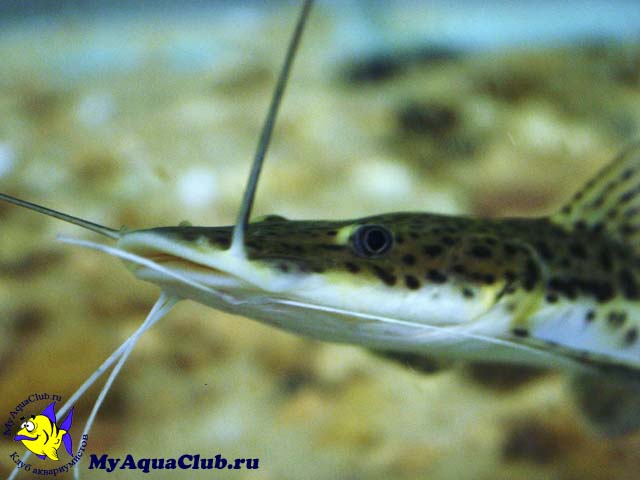 In the wild 6 feet max In the wild 6 feet max |
| Diet | Omnivore |
| Minimum tank size: | 1000 Gallons plus |
| Tank level | Bottom to middle |
| Care level | Moderate to advanced |
| Water parameters | 68-79℉ or 20-26.1℃, 5.5-7.2 pH, 3-12 dGH |
| Breeding | Oviparous |
| Suitable First Fish | No- Due to how fast they grow and the size of aquarium needed |
| Community Fish | No- They will eat smaller fish. Only house with fish of similar size |
| Food Types | Juveniles- pellets, meaty foods. Adults- Feeder fish, meaty foods and larger pellets |
| Cost: | From $17 - $500 depending on size |
Easily distinguishable by the red featured on its dorsal fin and tail, the RedTail Catfish is a peaceful fish with other species of its own size. Anything smaller than itself, however, will definitely become lunch!
Care of the RedTail Catfish is not particularly hard, but they do require huge tanks of a 1000 gallons plus. They also eat an incredible amount of food as they grow bigger even though it’s only once a week!
They also eat an incredible amount of food as they grow bigger even though it’s only once a week!
Both of these factors make this catfish not only too big for most standard homes but also too expensive to care for!
Unfortunately, due to the above, many RedTail Catfish end up being donated to local aquariums or being dumped in local rivers. This is mainly due to them outgrowing their home tanks and has now got to be such a huge problem that many aquariums have no room for any more.
They are also classed as an invasive problem fish in many river systems.
Color and Appearance of the Redtail CatfishThe Red Tail Catfish has an arrow-shaped cylindrical body with a flat belly and laterally compressed tail. Its mouth, as wide as its body, is shovel like with long whiskers/barbels protruding from the bottom. The eyes are set on either side of the head at the top and even on the larger specimens appear quite beady.
Of course, recognized for its reddish-orange that appears on the tail and tip of the dorsal fin the RedTail Catfish is also distinguishable by its horizontal stripe of white that starts just below the lower part of its mouth and runs down the entire body.
In juveniles this stripe is unbroken whilst in older specimens, it becomes broken just before the mouth. The rest of the Red Tail Catfishes body is brown to grey with small darker spots and a beige underbelly.
Usually offered for purchase at around 4 CMS there is nothing telling in the viewing of the RedTail Catfish that would lead you to believe it will grow to the gargantuan size that it does. Once you get it home, however, and in your aquarium, it will be capable of growing up to an inch per week.
These monsters of the aquarium can top out at an incredible three plus feet!
Where do Redtail Catfish come from?The RedTail Catfish is found naturally in the Amazon, Orinoco and Essequibo river basins of countries such as Colombia, Venezuela, Guyana, Ecuador, Perú, Bolivia and Brazil. Here, although preferring the deep pools found in the rivers, they can be found in a range of habitats.
These include rapids and flooded forests where they spend most of their time motionless on the river beds.
Not unsurprisingly, due to the irresponsible dumping of the RedTail Catfish, there are also large invasive populations of this fish in Florida, Nebraska, Missouri, Tennessee, and Texas. Recently they have also been discovered in the river systems of Thailand. The RedTail Catfish has not been assessed for the IUCN Red List.
These Catfish are fished by many anglers as they are a tough catch due to their size. Often putting up a good fight and using their 3-foot length and strength to test any competent angler.(Red Tail Catfish is a sort after prize for many anglers. Photo Credit@fishinginthailand)
Are Redtail Catfish Aggressive?The RedTail Catfish is a little contradictory when it comes to its behavior. It is both peaceful and aggressive, dependent on the circumstances it finds itself in. Placed with fish species that are of a similar size it will be amiable; smaller and it will be predatory and aggressive.
Placed in an aquarium by itself or with suitable tank mates the RedTail Catfish is shy and fairly inactive.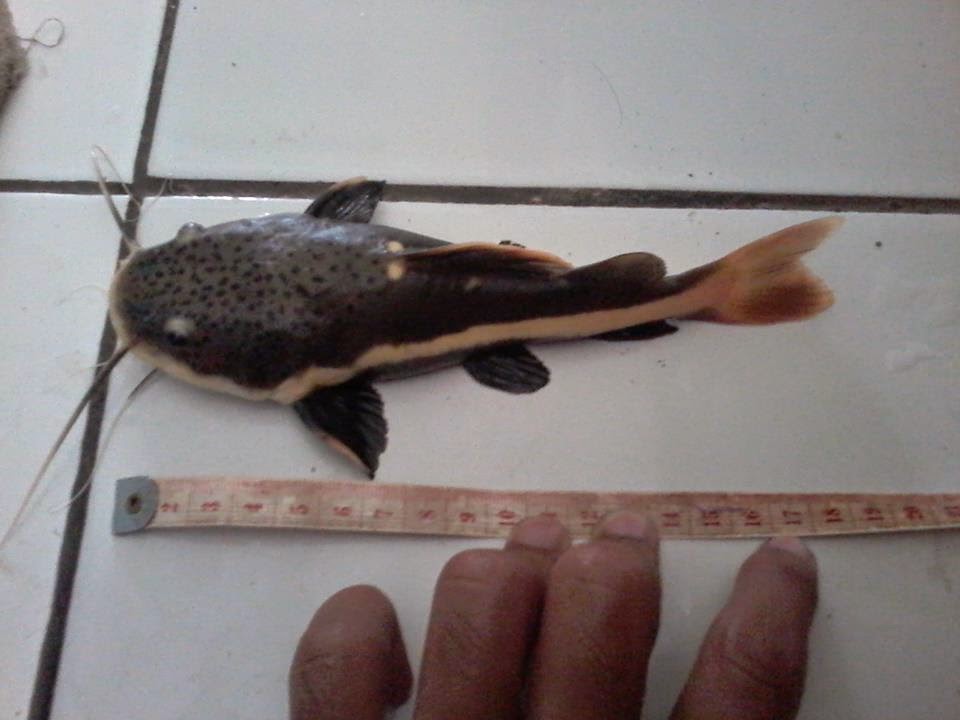 They will spend most of their time lazing on the bottom of the aquarium or hiding out in caves or dens. More interaction can be encouraged, however, by spending time with your RedTail Catfish and letting them get used to your presence. Some even become outgoing enough to hand feed.
They will spend most of their time lazing on the bottom of the aquarium or hiding out in caves or dens. More interaction can be encouraged, however, by spending time with your RedTail Catfish and letting them get used to your presence. Some even become outgoing enough to hand feed.
With a well developed chemosensory and stealth ability the RedTail Catfish is a predatory fish that lies in wait for prey. They can easily eat anything that is up to half the size of them but may even try for bigger. Choking is a fairly common side effect of these attempts, but being able to spit things out is a well known RedTail Catfish trait.
Some people have reported to being witness to their RedTails eating rocks which they can then spit back out at any given time.
How to care for Redtail Catfish
When it comes to the care of the RedTail Catfish, the first thing to consider is the aquarium size that these giants of the river need. If you cannot house one at its maximum size of around 3 feet in captivity, you really should not be considering purchasing one! These catfish grow fast, up to an inch per week, and a smaller aquarium will only be a VERY temporary home.
Requiring at least 1000 gallons but preferably nearer to 1500, the RedTail Catfish aquarium will not be suitable for most homes. This does not, however, rule you out from keeping one as an outside pond, the larger the better, is also ideal.
Keep in mind that the RedTail Catfish needs temperatures of 68-79℉ or 20-26.1℃ so may require a pond that is heated. If this is the case, they may also need bringing into a warmer environment during winter so you will need somewhere appropriate to keep them.
Financially, not only do the size of aquariums required by a RedTail Catfish run into the thousands of dollars price tag, but also the actual care of them can mount up financially too. Heating, filtration and the huge amount of food that the RedTail Catfish can consume will all be a drain on the wallet too!
Having a lifespan of around twenty years, the RedTail Catfish is a big responsibility and not one that should be undertaken lightly.
If you have decided to keep a RedTail Catfish, and I can’t blame you if you have, you will need to ensure that they have the correct setup aquarium.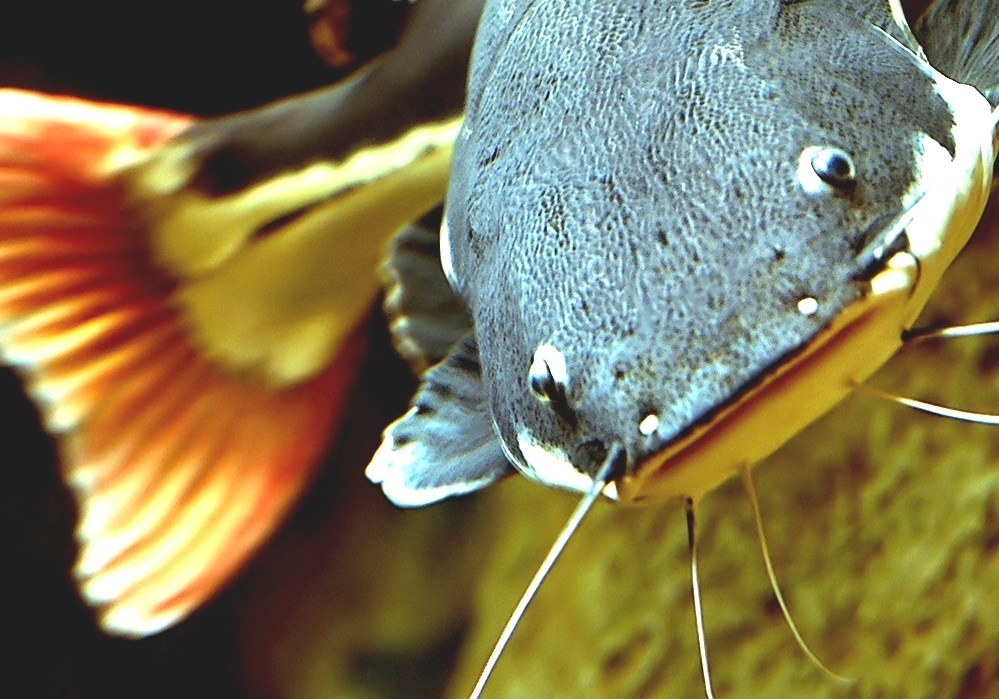 A large sump filter system will be required with an external heating source. These catfish have been known to eat internal filtration and heaters and using them is not a risk you want to run.
A large sump filter system will be required with an external heating source. These catfish have been known to eat internal filtration and heaters and using them is not a risk you want to run.
We highly recommend large external canister filters like the Fluval FX5 larger canister filter. We found the best prices over at Chewy.com and have provided you with a link to save you time.
The decor is also a source of ‘entertainment’ for these fish, so either keep it to a minimum or ensure that it is too heavy for the RedTail Catfish to move. You will need to provide hiding spots for Red Tails especially if you do not use subdued lighting which they far prefer. Caves, dens, large branches or big rocks are all ideal items for your RedTail Catfish to hide amongst.
Although they are a fairly hardy fish, it is still important to keep the RedTail Catfish aquarium within the recommended parameters.
Water changes and maintenance should be performed weekly with 30% of the water being exchanged. Should, for any reason, the water in their aquarium have problems or deteriorate your RedTail Catfish will let you know by swimming to the surface and gulping at the air.
Should, for any reason, the water in their aquarium have problems or deteriorate your RedTail Catfish will let you know by swimming to the surface and gulping at the air.
As a juvenile it is recommended that you feed your RedTail Catfish every other day, but as an adult just once a week. They are omnivores with a hearty appetite who can be very sluggish after feeding. This is due to them taking their time to digest food. They are also one of the most common species to become obese due to being overfed by their keepers, the diet they require and their inactivity.
Healthwise the RedTail Catfish is subject to the same diseases and illnesses as other tropical fish with obesity-related illness and poor water quality diseases being most common. High nitrate levels, for example, can cause infected barbels/whiskers which will lead to the RedTail Catfish being unable to navigate and eat properly.
Proactive prevention, as always, is the best course to take with RedTail Catfish illness but should yours fall foul to a disease it is vital you are very careful what treatments you use.
Catfish are a scaleless species and therefore cannot tolerate any medications that contain potassium permanganate or are copper based. Malachite green/Formalin is, however, a suitable choice providing you only use a ¼ to ½ the recommended dose.
What do Redtail Catfish eat?
As an omnivore the RedTail Catfish in its natural habitat feasts mainly on fish, crab, and crustaceans with fruit and seeds making up the rest of their diet. They are opportunistic predators that wait for ‘food’ to come along, or in the case of fruit and seeds fall into the water.
In captivity, RedTail Catfish require a varied and well-balanced diet to ensure that they do not become obese. As an already inactive fish in their natural habitat, they are even less active in captivity and the risk of overfeeding is high.
This is why it is recommended that as an adult you only feed these giants once a week.
There is a wide range of foods readily available that your RedTail Catfish will accept. It should, however, be noted flaked foods are only suitable for juveniles and that not all RedTails will accept flake foods. Larger food sticks like Tetra Jumbo Sticks will be accepted and sucked up from the surface in large amounts giving them all the nutrients they need from a staple food.
It should, however, be noted flaked foods are only suitable for juveniles and that not all RedTails will accept flake foods. Larger food sticks like Tetra Jumbo Sticks will be accepted and sucked up from the surface in large amounts giving them all the nutrients they need from a staple food.
Beef heart and chicken are also unsuitable for this species as some lipids these contain cannot be properly metabolized. This inability can cause problems such as excess fat deposits and even organ degeneration.
Suitable foods, high in protein, include prawns, mussels, cockles, lancefish, earthworms, crayfish, and cut up fish. As they grow older a RedTail Catfish will also easily accept a whole white fish! Crustaceans, it should be noted, are fantastic color enhancers to bring out the red in their tails and veg should also be given on a regular basis to balance out their diet.
If your fish becomes ill or starts to show unusual behaviors then read our complete guide to diagnosing and treating many of the common diseases in our complete guide.
You may be wondering why live feeders are not mentioned in the list of suitable foods for a RedTail Catfish! This is because, as though they are certainly a viable offering for this species, they can also be fraught with problems and are not a necessity.
Many live feeders nowadays carry parasites and diseases and are bred in such numbers and conditions that they contain very little to no nutritional value.
How to Breed and Sex Redtail Catfish
Although there have been some reports of success with breeding using hormones in South American fisheries, breeding in home captivity is thought to be impossible. This could be partly due to the Red Tail Catfishes territorial nature with its own kind and the inability on our part to be able to provide a large enough aquarium for them to cohabit.
In their natural habitat, Red Tail Catfish are oviparous and breed in the same manner as many other catfish. This involves the preference for a certain water temperature between 75-80℉ or 24-27℃ and a place to nestle in the rocks and weeds.
The female will then choose a spot that is secluded and easy to guard against predators and lay her eggs on a flat surface. An astounding number of eggs can be laid in one spawning, starting at a few hundred and going up to approximately 21,000! The younger smaller females tend to lay the lesser numbers, whilst the older and larger lay the most.
Next, the male will spray the laid eggs with sperm to fertilize them, they will hatch within about ten days. It is not known whether either the female or the male guards the eggs whilst they are hatching but it is believed to be so. The male also will protect the fry for around a week before they up and leave the nest.
Suitable Redtail Catfish Tank Mates
Known as a territorial fish with its own species and other catfish in the Pimelodidae family the RedTail Catfish is best kept solitary. They can, however, make a good community tank member with other species providing they are of a good size and in an appropriately sized aquarium.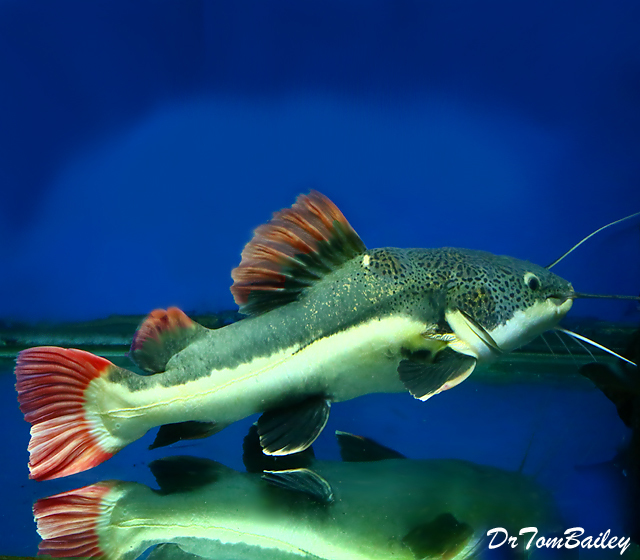
Gars, stingrays, datnoids, black pacu, giant gourami and iridescent sharks all fall into the category of recommended tank mates. Shrimps, crabs, snails and other fish that are smaller all fall into the category of lunch! Sailfin and common plecostomus can also make good tank mates mainly due to their armored defense. It is recommended that RedTail Catfish and potential tank mates are raised together from a young age.
Oscar’s also made good tank mate for the RedTail Catfish, just make sure they are a good size!
Conclusion: Redtail Catfish Ultimate Care Guide
There is absolutely no doubting that the Red Tail Catfish is one of those fish that many would love to own. This is especially true of those fish keepers who thrive on keeping the so-called ‘monster fish’ that others can only aspire to own.
It has to be said though and it can’t be said too many times, that to take one of these spectacular catfish on you have to have the correct setup and set up size. You also need the money to fund this and the Red Tail Catfishes voracious appetite. With a lifespan of around twenty years, it is going to be one expensive food bill!
You also need the money to fund this and the Red Tail Catfishes voracious appetite. With a lifespan of around twenty years, it is going to be one expensive food bill!
Having said all that, however, if you have got the funds and the means, the Red Tail catfish really is a truly beautiful giant of the deep. I, for one, would happily keep one again, if only I had space!
Happy Fishkeeping Forever!
[author title=”About the Author”]
- Author
- Recent Posts
Carl Broadbent
I have been working in the tropical fish industry for over 30 years now and I'm still learning. Everyday is a school day in this hobby. In my spare time I play golf very badly!
Latest posts by Carl Broadbent (see all)
- Comparing Aquarium Gravel To Sand – Which Is Best For Your Tank? - November 18, 2020
- Silver Arowana: Complete, Care, Breeding, Feeding Guide - November 16, 2020
- Rainbow Shark: Diet | Size | Breeding | Cost - November 16, 2020
care, maintenance, reproduction, compatibility, food, photo-review
Not all aquarists like small fish species. Some of them tend to keeping a small number of large fish. If you belong to this category and have the opportunity to start aquarium for several tons of water, then an Amazonian handsome man will be an excellent choice - red-tailed catfish. How to keep such a giant at home learn from our article.
Some of them tend to keeping a small number of large fish. If you belong to this category and have the opportunity to start aquarium for several tons of water, then an Amazonian handsome man will be an excellent choice - red-tailed catfish. How to keep such a giant at home learn from our article.
Contents
General information
Redtail (Orinoco) catfish (Phractocephalus hemioliopterus) is a freshwater ray-finned fish from the family Pimelod, or Flathead catfish.
Characterized quite large in size (up to 130 cm). It's hard to imagine, but such a giant has become a fairly common aquarium fish. Unfortunately, there are still places where juveniles of these catfish are sold as beautiful ornamental fish, silent at times about the immodest sizes of adults. Surprisingly, growth even the volume of the aquarium does not hold back the red-tailed catfish. excellent appetite and boundless gluttony lead to the fact that the fish grows right before our eyes.
The species lives in South America. It belongs to omnivorous fish, although animal food is preferred. The red-tailed catfish hunts at night from an ambush.
It belongs to omnivorous fish, although animal food is preferred. The red-tailed catfish hunts at night from an ambush.
Local the population uses red-tailed catfish (which are called "pirarara" here) in as a food object, although their meat is dark in color. View artificially is bred in fish farms of some countries of Southeast Asia, from where also goes on sale as aquarium inhabitants. Is desired trophy in sport fishing.
To scare larger predators or simply unwanted guests, red-tailed catfish able to make loud sounds, reminiscent of the roar of an elephant. For this fish sharply passes a mixture of water and air through tightly pressed gills. For such The nickname "screaming fish" was attached to the catfish.
Worth noting that the Orinoco catfish is unpretentious in content, quickly gets used to the owner and even allows himself to be petted and hand-fed. Often found in public aquariums and aquariums.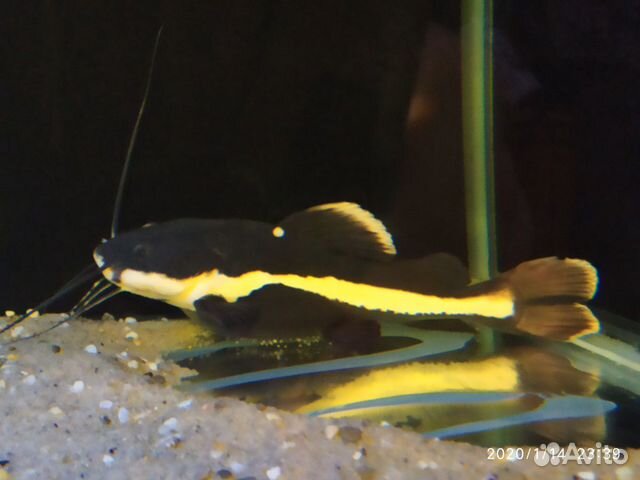
Appearance
Redtail catfish has an elongated, powerful body. The head is large, flattened with a wide mouth and big eyes. The mouth opening is bordered by three pairs of long whiskers - one on upper jaw and two on the lower jaw.
All fins well developed. The tail is single, there is a well-defined adipose fin.
Redtail catfish. AppearancePainting Orinoco catfish is quite attractive. The upper body is dark, the lower - white. Numerous black spots are scattered on the head. With a torso the caudal fin, painted bright orange or red, contrasts. The top of the dorsal fin has the same color.
Maximum the recorded body size is 135 cm. In small aquariums, the fish rarely grows more than 60 cm.
The red-tailed catfish is a real long-liver, able to live up to 20 years in captivity.
Habitat
Motherland red-tailed catfish are the warm tropical waters of the rivers of South America, related to the Amazon and Orinoco basins. The water here is soft and acidic, at the bottom you can find a large number of snags that serve as shelters for dusk hunting. Catfish was artificially settled in the southern states of the United States and countries South-East Asia.
The water here is soft and acidic, at the bottom you can find a large number of snags that serve as shelters for dusk hunting. Catfish was artificially settled in the southern states of the United States and countries South-East Asia.
Care and content
Considering the huge size of red-tailed catfish, an aquarium for them will need a very big. One individual should account for at least 300 liters, although ideal aquariums for this species are containers for several tons of water. Orinoksky catfish leads a benthic lifestyle, so it is desirable that the bottom area be as possible more. The older the individual, the more time it spends without movement, lying on the bottom.
In an aquarium with these catfish should not be abused with decorations. They can easily flip any a loose thing, and in the worst case, even break the glass. Design must be as ascetic as possible. You can put a few large snags, which become a refuge for the fish. It is not recommended to use sand as a soil and small pebble.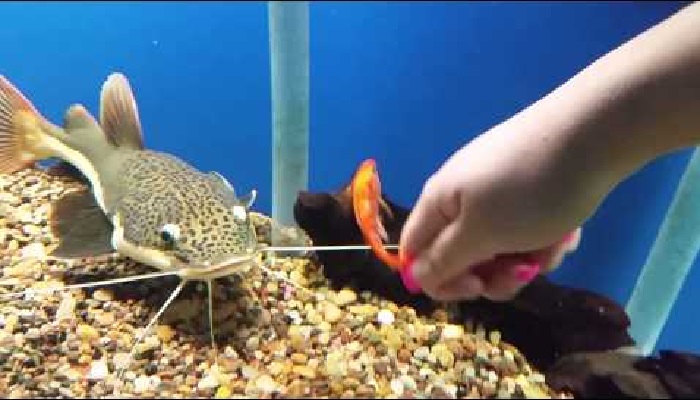 Red-tailed catfish love to swallow the soil and skip them through the gills. So that the fish do not accidentally damage them, it is better to stop at medium and large stones, or even leave the aquarium without soil, which also makes it easier to clean up leftover food.
Red-tailed catfish love to swallow the soil and skip them through the gills. So that the fish do not accidentally damage them, it is better to stop at medium and large stones, or even leave the aquarium without soil, which also makes it easier to clean up leftover food.
Planting live plants in the dwelling of the red-tailed catfish is completely impractical. They will be quickly destroyed by a flat-headed predator.
Redtail catfish will require a large aquariumNatural gluttony and preference for animal food requires the installation of powerful filters and compressors. Red-tailed catfish do not like bright light, preferring soft and subdued ones. It is important to note that, whenever possible, it is necessary to use an external equipment (for example, a thermostat, a thermometer, etc.), this giant has nothing do not break them even with a small blow of the tail. Needed once a week change 20% of the volume of water in the aquarium.
Optimal water parameters for maintenance: Т=22-28°С, pH=6.
0-7.0, GH=2-10.
Compatible
At a glance it seems that the phlegmatic, constantly lying at the bottom catfish is not capable of anyone offend, but this impression is false. Can be done at any time a sharp throw and the unlucky fish will be in the huge mouth of a predator. That's why the joint maintenance of the red-tailed catfish with any species, less than it size is doomed to fail. Moreover, even large fish are not immune from being eaten. Orinoco catfish. Sometimes they grab prey, which is only a third less than them.
Hence the conclusion: the ideal option for keeping red-tailed catfish would be a large aquarium with a single inhabitant.
Red-tailed catfish in a community aquarium If the desire to keep catfish with other fish is haunting, then you should pay attention to large aquarium inhabitants - arowana, astronotus, Managuan cichlazoma, black pacu, pterygoplicht, pangasius. However, do not forget that each new tenant of a large size will require a proportional increase in the volume of the aquarium.
Spacious containers, it is possible to contain several individuals of red-tailed catfish, but it is impossible forget about their pronounced territoriality, which often leads to bloody skirmishes.
Redtail feeding catfish
Natural diet red-tailed catfish is extremely diverse. This inhabitant of the Amazon is completely promiscuous and eats everything it can catch: fish, worms, crustaceans and fruits that have fallen into the water. If the opportunity presents itself, he will easily feast on small amphibians, reptiles and even rodents. As seen, preference is given to animal food.
Food base for such a large predator are, first of all, seafood: white fish fillet rocks, mussels, peeled shrimp. It is useful to introduce small pieces into the diet fruits, scalded lettuce leaves.
Not recommended feed red-tailed catfish with products from the meat of warm-blooded animals (chicken, beef, etc.), because they are practically not absorbed by fish, can lead to obesity and problems with internal organs.
Unfortunately, most catfish, especially adults, do not favor dry food. Can be offered sinking tablets for bottom fish, e.g. Tetra Tablets TabiMin (XL). There are cases when they fell on catfish according to taste.
Always Offer catfish a varied diet. It was noted that when feeding one and the same product day by day the fish become so accustomed to it that refuse other food. Young fish need to be fed daily. adults is better several times a week. Follow the rules of nutrition remember that catfish will swallow food again and again, they have a sense of proportion is absent, and this is a direct path to obesity and rapid water pollution.
Propagation and breeding
Obtain offspring from red-tailed catfish at home is possible only if you you are the proud owner of a warm decorative pond for several tons water. It is in such conditions that fish are bred in fish farms. South-East Asia.
Cases breeding in an aquarium has not yet been recorded.
Red-tailed catfish: photo, content, compatibility, feeding
Red-tailed catfish (lat. Phractocephalus hemioliopterus) is named after the owl's bright orange tail fin. Beautiful, but very large and predatory catfish. For its maintenance, a very spacious aquarium is needed, from 300 liters, and for adults up to 2 tons. Moreover, it grows very quickly and will soon need a much larger aquarium. Catfish are not very active during the day, they need hiding places where they will spend part of the day. Predator. Everything that he can swallow will be eaten, or maybe he is a lot.
Phractocephalus hemioliopterus) is named after the owl's bright orange tail fin. Beautiful, but very large and predatory catfish. For its maintenance, a very spacious aquarium is needed, from 300 liters, and for adults up to 2 tons. Moreover, it grows very quickly and will soon need a much larger aquarium. Catfish are not very active during the day, they need hiding places where they will spend part of the day. Predator. Everything that he can swallow will be eaten, or maybe he is a lot.
Content
- 1 Handing in nature
- 2 Description
- 3 The complexity The red-tailed catfish lives in South America. It is also known by the names: as well as: Orinoco catfish, flathead, fractocephalus. The red-tailed catfish lives in the Amazon, Orinoco and Essequibo river basins in South America, Ecuador, Venezuela, Guyana, Colombia, Peru, Suriname, Bolivia and Brazil. It is found only in fresh water and inhabits larger rivers, streams and lakes. In local dialects, it is called pirarara (pirarara) and cajaro (cajaro).

Lives in South America in the Amazon, Orinoco and Essequibo. The inhabitants of Peru call the red-tailed catfish - pirarara. In nature, it reaches 80 kg and body length up to 1.8 meters, but nevertheless it is a very popular aquarium fish. Red-tail catfish, even in small aquariums, grows very large.
Because of its sheer size, this catfish is a coveted trophy for many professional anglers. The current IGFA world record belongs to the Brazilian Gilberto Fernandez, who caught a catfish weighing 56 kg. Although it is claimed that the locals do not eat it because of the black color of the meat.
Description
Fractocephalus dark gray dorsally with scattered black spots. Huge mouth, the same width as the body, the lower part of its color is white. There is a pair of mustaches on the upper lip, and two pairs on the lower lip.
A white stripe runs from the mouth along the body to the tail and is grey-white on the side. The caudal fin and the tip of the dorsal are bright orange.

The eyes are located high on the head, which is characteristic of a predator.
Phractocephalus hemioliopterus can reach about 1.8 m in length and weigh about 80 kg. However, this happens extremely rarely, and most of them reach an average of 3.5–1.1–1.4 m in length. Naturally, in an aquarium, the catfish is even smaller and its size is highly dependent on the size of the aquarium.
Life expectancy of red-tailed catfish is up to 20 years.
Content Difficulty
Although the description is for informational purposes, we strongly advise against keeping this fish unless you can afford a phenomenal size tank.
The requirements for the aquarium described above are underestimated, and 2,000 liters is more or less a real figure.
 Catfish are kept in zoos abroad…
Catfish are kept in zoos abroad… Unfortunately, recently red-tailed catfish has become more accessible and is often sold to unknowing people as quite a common species.
It quickly grows to a gigantic size and aquarists don't know what to do with it. A common solution is natural reservoirs, and if it does not survive in our latitudes, it can become a problem for the United States.
Content in the aquarium
Recommended parameters:
- soil-Any
- Light-moderate
- Water temperature from
- РН 5.5-7.2
- Camera
- Current-moderate
The fish keeps in the bottom layer, when it gets older, it can lie motionless for hours.
To put it bluntly, conditions can be spartan for redtail catfish. Moderate light, some snags and large rocks for cover.
But make sure that everything is well fixed and will not move, catfish can knock down even heavy objects.
Any soil, but they can swallow gravel and damage delicate gills.
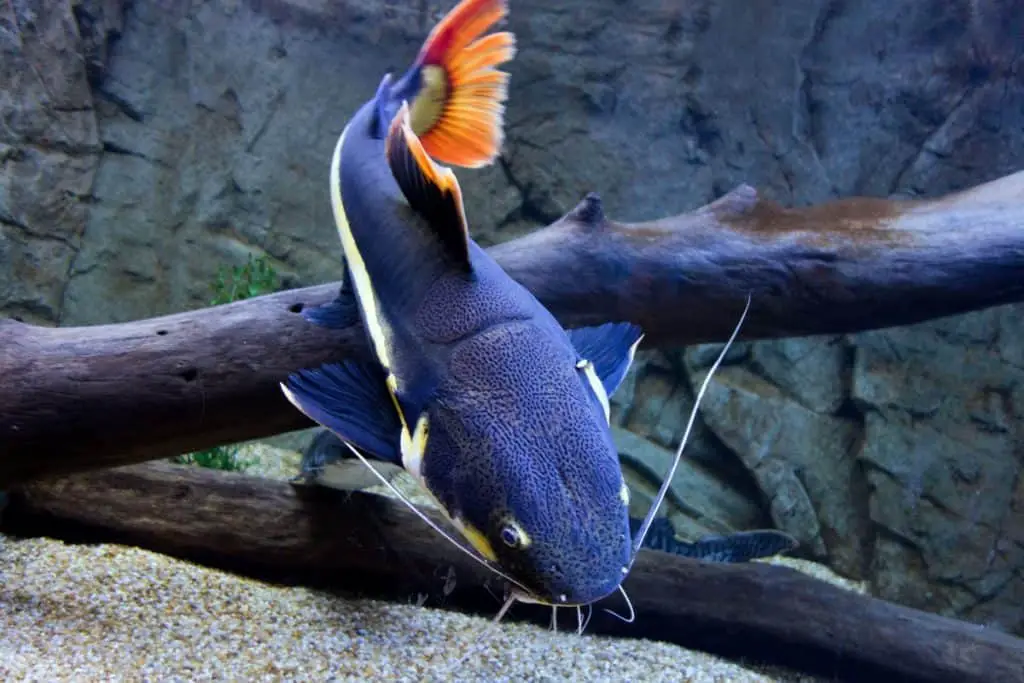 Sand is a good choice, but don't expect to find it the way you want it to be, it will be constantly dug up.
Sand is a good choice, but don't expect to find it the way you want it to be, it will be constantly dug up. The best choice is a layer of small, smooth stones. Or you can abandon the soil, it will be much easier to maintain the aquarium.
Strong external filter required, redtail catfish produce a lot of waste. It is better to keep all possible devices outside the aquarium; catfish easily destroy thermometers, sprayers, etc.
Feeding
Omnivorous by nature, it eats fish, invertebrates and fruits that have fallen into the water. In the aquarium, it eats shrimp, mussels, earthworms and even mice.
What to feed is not a problem, the problem is to feed. Large catfish can be fed fish fillets, white breeds.
Try to feed varied, catfish get used to one food and may refuse another. In the aquarium, they are prone to overeating and obesity, especially on a protein-rich diet.
Juvenile red-tailed catfish need to be fed daily, but adults can be fed less often, even once a week.

Do not feed mammalian meats such as beef heart or chicken. Some substances included in the meat are not absorbed by catfish and lead to obesity or disruption of the internal organs.
Similarly, it is unprofitable to feed live fish, viviparous or golden, for example. The risk of infecting the fish is not comparable to the benefit.
Compatibility
Redtail catfish are extremely popular fish in show and community aquariums, where they are often housed with other large fish such as black pacu and other large catfish.
Even as juveniles only a few centimeters long, they are capable of swallowing many of the most common aquarium fish (such as blue neons or guppies), and it is appropriate to house these fish only with other relatively large species.
Although the redtail catfish will hesitate to swallow any small fish, it is quite peaceful and can be kept with fish of equal size. True, this requires an aquarium that you can hardly keep at home.












